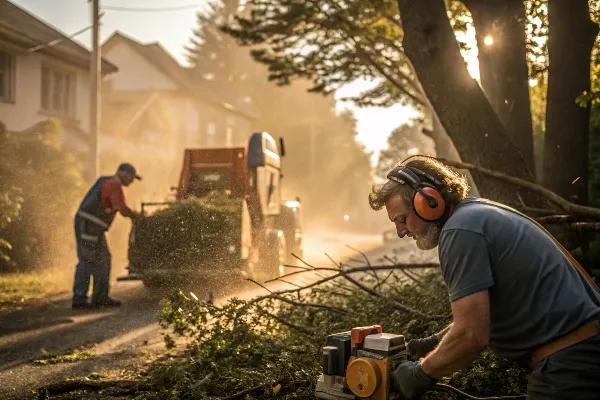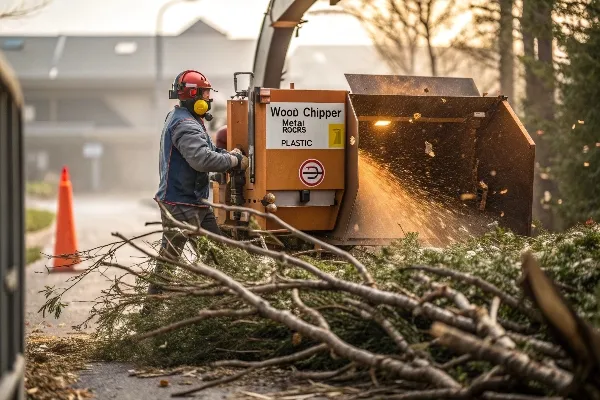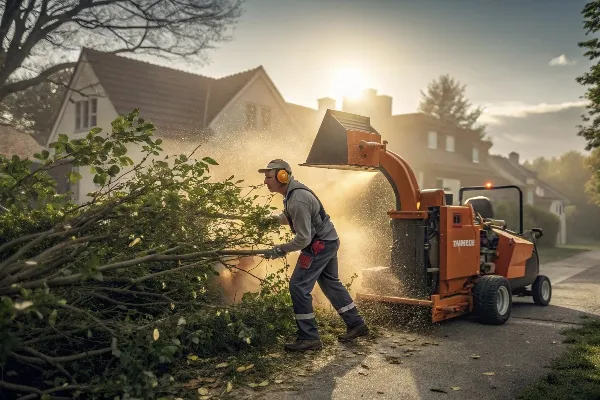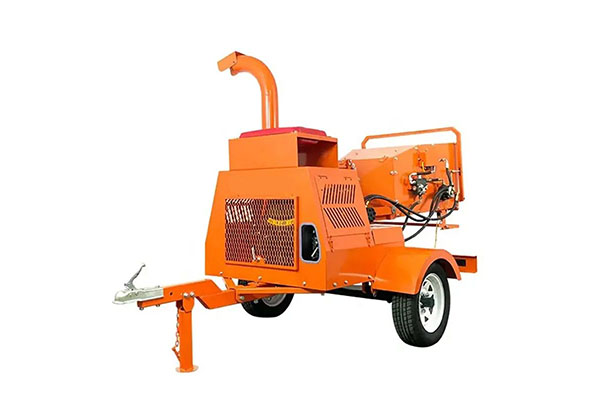Avoid your inquiry is delay response, please enter your WhatsApp/Skype along with the message, so we can contact you at the very first time.
We will reply you within 24 hours. If for urgent case, please add WhatsApp/WeChat: +8613791936882 ,. Or call +86-18678911083 directly.
I notice many homeowners feel overwhelmed by piles of branches that clutter their yards. They want a quick way to handle debris but worry about safety and time.
People use wood chippers to quickly reduce large branches into manageable mulch. These machines save time, recycle waste, and help maintain tidy outdoor spaces.

Why do people use wood chippers
I remember feeling frustrated after a storm knocked down several limbs in my garden. I tried cutting them by hand. That took hours and left me exhausted. Then I borrowed a wood chipper. It converted tangled debris into neat chips that I could use for landscaping. I realized how valuable these machines are for both convenience and sustainability, so I started researching them more deeply. I learned that they come in various sizes and power levels. They also have safety features like emergency shutoff bars and sturdy hoods. Now, whenever my friends ask how to deal with fallen branches, I suggest a wood chipper.
I see people treat wood chippers like general waste disposals. They imagine any leftover junk can go inside. That can be hazardous or damage the machine.
Never feed non-wood items, such as stones, metal, or plastic, into a wood chipper. Those objects harm the blades and risk injury. Stick to yard waste only.

What not to put in a wood chipper
I learned about dangerous chipper blockages when I first shared a rented machine with neighbors. One neighbor tried chipping an old fence post that had embedded nails. The chipper jammed, and sparks flew around. That incident taught me to inspect every branch for metal pieces or foreign objects.
Wood chippers are designed for organic matter. They do an excellent job shredding branches, bark, and similar debris. Yet they cannot handle items like metal hardware, glass, or plastic. The strong metal blades inside rotate at high speed. If a non-wood object confronts those blades, the impact can break or bend the cutting edges, especially if the object is dense or has an odd shape. That leads to expensive repairs or even total machine failure. Chippers themselves are robust, but they are not indestructible.
I have also seen cardboard or plastic packaging accidentally go into the chute when someone cleaned a yard with loose trash around. Such materials cause problems. Plastic can wrap around the cutting assembly, clog the discharge chute, or melt from friction. Cardboard lacks the right consistency and can form thick clumps. Worse yet, small pebbles picked up with leaves can become projectiles. They ricochet around the feed hopper. The operator can suffer a serious injury from flying debris.
Pressure-treated or painted wood also poses problems. That wood might contain harmful chemicals. When shredded, those chemicals can contaminate the mulch. I had an acquaintance who unknowingly spread treated-wood chips around a vegetable patch. Later, they learned the residue could be bad for plants and soil. This scenario is another reason to keep chipping limited to branches and other natural scraps. If you must recycle older lumber, look for specialized waste facilities instead.
Below is a table listing common items to avoid:
| Item | Reason It Is Dangerous or Unsuitable |
|---|---|
| Stones or gravel | Cause blade damage, produce flying debris |
| Metal (nails, screws, wire) | Sparks, can jam or destroy chipper blades |
| Glass | Shatters into dangerous shards |
| Plastic and packaging | Melts or tangles in rotating components |
| Pressure-treated lumber | Releases chemicals into mulch or air |
In my experience, prevention is best. Before chipping, I sort my yard waste. I use a simple tarp to catch larger branches. I remove any attachments that look suspicious, like leftover nails or brackets. If I find big lumps of dirt, I knock them off. A short inspection saves me repairs and prolongs the machine’s life. That extra preparation also keeps me and others safe.
I often hear a roaring sound when a wood chipper starts up. Neighbors might stare. A friend even joked that my chipper sounded like a helicopter landing in my yard.
Yes, most wood chippers are noisy. They have powerful gas engines and fast-spinning blades that produce high decibel levels. Ear protection helps.

wood chipper noise
Noise is one of the big concerns many people have. It was for me too. I did not want to disturb my neighborhood or damage my hearing. I discovered that chippers produce loud sounds because of their heavy-duty engines plus the rapid action of the cutting assembly. The engine alone generates plenty of noise, especially if it is a gas-driven model. The blades strike wood at high speed, which adds another layer of grinding and splitting sounds. The forceful discharge of chips also contributes to the overall racket.
I measure noise by decibels (dB). A typical consumer chipper runs in the range of 90-110 dB. That puts it above normal conversation levels and near thresholds that can start to harm hearing if I stand too close for a long time. Ear protection, such as earmuffs or earplugs, is essential. When I operate a chipper, I never skip hearing protection. I also let neighbors know in advance. Scheduling chipping in mid-morning or early afternoon helps me avoid conflicts. I try not to run it very early or late at night.
Electric chippers are sometimes less noisy than gas-powered ones, though the difference might not be huge. An electric chipper may have a lower-power motor, which can reduce overall volume. However, the sound of the blades tearing branches remains prominent. The electric motor hum might be softer than the roar of gas engines, but it is still loud enough that ear protection1 is usually needed.
Noise can also vary based on the size of branches. Thicker limbs produce heavy grinding and can rattle the entire machine. Small twigs and leaves tend to go through more quietly. If I have a mix of debris, the volume can fluctuate. A steady stream of medium-diameter branches can produce a constant, droning grind that echoes around the yard.
Below is a table comparing possible noise sources:
| Noise Source | Typical dB Range | Effect |
|---|---|---|
| Gas Engine | 90-100 dB | Loud, rumbling, can carry over distance |
| Blade Impact | Varies (could reach 110 dB) | Sharp grinding, sudden volume spikes |
| Discharge Chute | 80-90 dB | Moderate noise, forced airflow |
| Electric Motor | 75-90 dB | Quieter hum, though still requires care |
If you are concerned about noise, several tips can help. Always position the chipper away from windows or doors. Use natural barriers, like fences or shrubs, to block some sound. Make sure the machine is on a stable surface to minimize vibration. Also, many local ordinances restrict noisy equipment to certain hours. I learned that it is best to check those rules if I live in a densely populated area.
For me, the benefits outweigh the temporary noise. I reduce my yard waste and produce mulch that I can reuse. I simply wear protective equipment and keep an eye on the time of day. The payoff is a cleaner garden and fewer trips to the landfill.
I sometimes debate whether an electric chipper is worth it. Many commercials show smaller, plug-in machines that promise quiet operation. People ask if they can handle thick branches or if they stall too easily.
Electric wood chippers are good for light to moderate yard debris. They run quietly and require less maintenance. However, heavy-duty jobs may need gas-powered models for more power.

Are electric wood chippers any good
I recall my own transition from a larger gas-powered chipper2 to a smaller electric model. I wanted less noise and an easier startup. My gas chipper was great, but it needed regular engine maintenance. The spark plugs and carburetor gave me occasional headaches. I also had to store gasoline safely. One day, I decided to test an electric chipper in my backyard. The difference was immediate.
First, I enjoyed the hassle-free startup. I only had to plug it in and flip a switch. The motor sprang to life without unpredictable pulls on a recoil starter. This convenience made quick yard cleanup more appealing. In the past, I would sometimes delay minor tasks because fueling the gas chipper seemed like extra work. The electric version was simpler, so I used it more frequently.
Second, it produced moderately less engine noise. I still heard the blades slicing through branches, but the overall volume felt lower. That quieter operation made it easier for me to have a short conversation nearby. Though I still wore ear protection, I did not feel as overwhelmed by engine roars. My neighbors complained less, which was a welcome relief.
Third, electric chippers demand a steady power source. That means I need an outdoor-rated extension cord or an outlet close to my work area. For smaller yards or suburban lots, this is manageable. If someone has acres of land, a gas unit might be more practical because they do not need a long cord. In addition, electric models usually have lower horsepower. That might be fine for branches up to about 1.5 or 2 inches in diameter, depending on the chipper’s specifications. If I want to handle thicker limbs, I sometimes have to cut them down further or upgrade to a stronger machine.
Maintenance is simpler with electric models. I do not worry about oil changes or stale fuel. I keep the blades clean and check any debris buildup inside the chute. There are times when the motor might slow down if I feed too large a branch. The chipper can trip a breaker if overloaded. I learned to feed one branch at a time, respecting the chipper’s capacity. With practice, it remains a reliable choice for everyday yard tasks.
Below is a simple comparison chart:
| Feature | Electric Chipper | Gas-Powered Chipper |
|---|---|---|
| Startup | Immediate with flip of a switch | Manual pull; can be temperamental |
| Noise Level | Moderate, mostly blade noise | Louder engine, intense blade action |
| Power Source | Requires outlets and cords | Mobile, needs gasoline or oil mix |
| Branch Capacity | Typically smaller diameter (1-2 in.) | Can handle larger limbs (3+ in.) |
| Maintenance | Low, mainly blade checks | Higher, includes engine upkeep |
One must consider the scope of yard tasks when choosing an electric chipper. If you have small trees or frequent storms, a gas chipper’s power might be justified. But if you just want to shred leaves, twigs, and modest branches, an electric option is often enough.
I enjoy the lower fuss of electric chippers. I like that I do not have to deal with exhaust fumes. They fit well in suburban or tighter spaces. I can tidy up my garden weekly. At the end, I am left with mulch that I spread around flower beds or small trees. That helps soil moisture and weed control. Electric chippers are far from weak; they serve well if I stay aware of their limits. I believe many homeowners do not need the mega power of gas engines. For me, the consistent convenience makes it a winning choice in typical yard cleanups.
People use wood chippers because they handle large yard debris efficiently. They are noisy and need proper care, but they transform waste into useful mulch with minimal hassle.